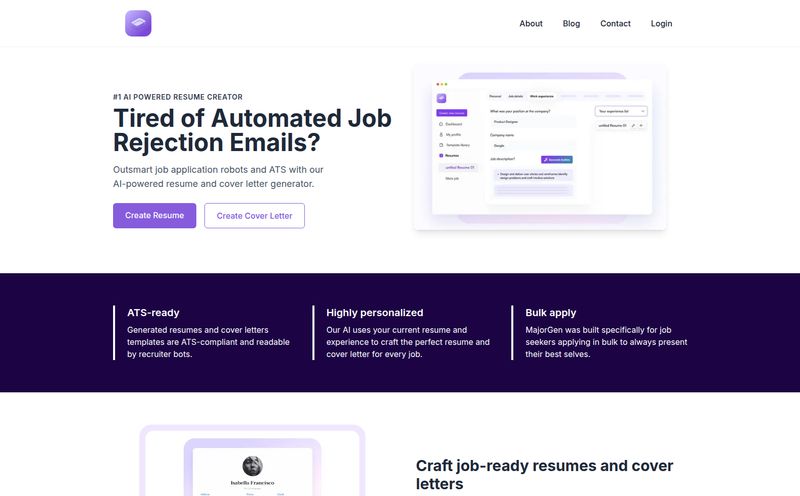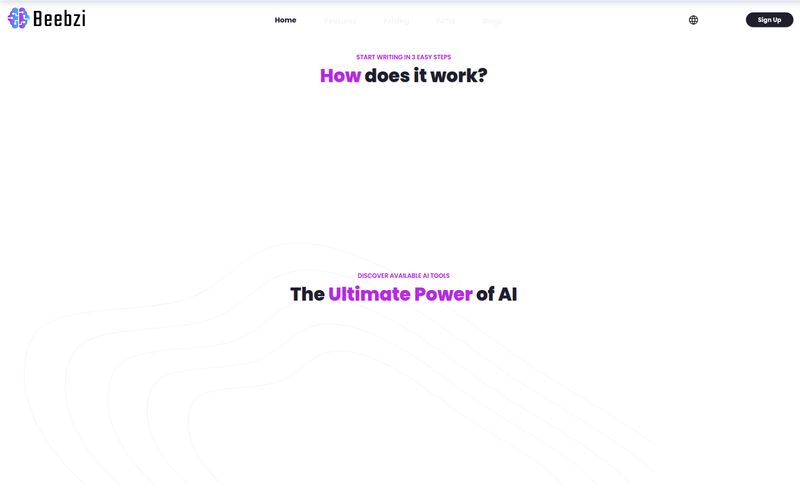I’ve been in this digital content game for a long, long time. I’ve seen platforms rise and fall like Roman empires. We built our castles on Geocities, our communities on MySpace, our businesses on Facebook pages, and our careers on Twitter feeds. And what did we learn? We learned that we were building on rented land. One algorithm change, one sudden acquisition, and poof—years of work could be kneecapped overnight.
So when a new platform comes along, especially in the newsletter space, my cynical SEO-brain usually scoffs. Another Substack clone? Another Medium wannabe? But every now and then, something feels… different. When I first landed on Paragraph’s homepage, I was met with, well, a whole lot of nothing. Just a clean, off-white canvas and a simple invitation to “Start writing.” It felt less like a platform and more like a promise: a fresh start.
And let me tell you, after digging in, Paragraph isn’t just a fresh coat of paint on an old model. It’s a fundamental rethinking of who holds the power in the creator economy. It’s got a bit of that Web3 secret sauce, and it might just be the thing we need to finally own our work. For real this time.
What Exactly is Paragraph? (And Why It's Not Just Another Substack Clone)
Okay, let's get the basics out of the way. On the surface, Paragraph is a newsletter platform. You write stuff, people subscribe, you send it to their inboxes. Simple enough. But that’s like saying a Tesla is just a car with a battery. The real magic is under the hood.
Unlike its predecessors that lock your audience into their ecosystem, Paragraph is built on the idea of true audience ownership. It uses Web3 technology—don't worry, we'll break down what that means—to give you a direct, unbreakable connection to your readers. This isn’t just about exporting a CSV file of email addresses. This is about building a community that can’t be taken away from you. Ever. It’s a subtle but massive shift in power from the platform back to the writer. A welcome change, if you ask me.

Visit Paragraph
The Core Features That Actually Matter to Writers
I’ve seen countless platforms boast a “plethora” of features that nobody actually uses. Paragraph, refreshingly, focuses on a few things that directly address the biggest pain points for modern creators: ownership, monetization, and well, the occasional bout of writers block.
True Audience Ownership: Your List, Your Rules
This is the big one. On most platforms, your followers are just a number on your dashboard. On Paragraph, readers can subscribe the old-fashioned way with their email, or they can connect with a crypto wallet. Why does the wallet part matter? A wallet address is a unique, user-owned identifier on the blockchain. When someone subscribes with a wallet, that connection is yours. It's not tied to Paragraph's servers or subject to their terms of service. It’s like the difference between having your friend's phone number saved in your own phone versus only being able to contact them through an app. One is a direct line; the other can be shut off.
Monetization That Goes Beyond a Simple Paywall
Let's talk money. We all gotta eat. Standard paid subscriptions are here, of course—you can set up recurring fiat payments just like you would anywhere else. But this is where things get really interesting.
- Collectible Posts: Imagine turning one of your best articles into a limited-edition, digitally signed collectible. With Paragraph, you can “mint” a post as an NFT. Your biggest fans can then buy and own it, proving their early support. It’s like a digital first edition, and it's a way for readers to invest in you directly.
- Token-gated Content: This is next-level community building. You can restrict access to certain posts for people who hold a specific NFT or a certain amount of an ERC20 token. Think of it as a secret clubhouse. Do you run a finance newsletter? Maybe you can create a special token for your paid members, and holding that token unlocks your exclusive deep-dive analysis. It turns your audience from passive readers into active stakeholders.
Your AI Writing Partner, Built Right In
Even the best of us stare at a blinking cursor from time to time. Paragraph has integrated GPT-4 directly into its editor. I’m generally skeptical of AI writing tools replacing genuine human creativity, but for certain tasks, it’s a godsend. I've found it's less about writing for you and more about being a creative partner. It's perfect for brainstorming a dozen different headlines, rephrasing a clunky sentence, or just giving you a prompt to get the words flowing. Don't think of it as a robot writer, think of it as the ultimate thesaurus and brainstorming buddy who never needs a coffee break.
The Web3 Learning Curve: Is It a Hill or a Mountain?
Alright, let’s address the elephant in the room. Words like “NFT,” “crypto wallet,” and “token-gating” can sound intimidating. And for some, it will be a barrier. If your audience isn't remotely tech-savvy, explaining why they might need a MetaMask wallet to read your premium content could be a tough sell. There's definitely a learning curve here, and Paragraph is betting on creators being willing to climb it.
But here’s my take: is it a mountain? No, I think it's more of a steep hill. A few years ago, the idea of paying a stranger on the internet for their newsletter seemed weird, now it's a billion-dollar industry. The tools to create and manage wallets are getting simpler every day. For writers in the tech, finance, art, or gaming spaces, your audience is likely already familiar with these concepts. For them, this isn't a bug; it’s a feature. It shows you're on teh cutting edge.
Let's Talk Pricing
This is the part of the review where I’d normally break down a pricing table. But as of writing this, Paragraph doesn't have a public pricing page. This is pretty common for Web3-native platforms. Often, the model is to make the platform free to use and instead take a small percentage of the transactions you process—whether that's from a paid subscription or an NFT sale. This is an educated guess on my part, of course. I'd strongly suggest you visit their site directly for the most current information, as these things can change fast.
So, Who Should Actually Use Paragraph?
Paragraph is not a one-size-fits-all solution, and that's okay. It shines for a specific type of creator.
You should seriously consider Paragraph if you are a forward-thinking writer or creator who is tired of building your business on someone else's platform. If you write about technology, cryptocurrency, finance, digital art, or gaming, your audience is primed for this. If you want to experiment with new revenue streams and build a truly dedicated community of super-fans, this tool is practically built for you.
However, if you're a casual blogger who just wants the absolute simplest path to a standard paywall, and the idea of explaining a “wallet” makes you break out in a cold sweat, you might be better served by a more traditional platform like Substack for now. If you're a code-savvy power user who wants to self-host and customize every pixel, Ghost remains the king of that domain.
My Final Verdict: Is It Worth Making the Switch?
Here’s the bottom line. Paragraph is exciting. It represents a philosophical shift that I, as a creator who values independence, find incredibly appealing. It feels like we're on the cusp of a new phase of the internet, and tools like this are laying the groundwork. It's not perfect, and it's not for everyone—not yet, anyway.
Using Paragraph today feels a bit like starting a blog in 2005. It was a little niche, a little technical, but those who got in early and understood its potential built incredible things. If you’re willing to be a bit of a pioneer and want to build a content business that's truly future-proof, then yes, I think making the switch is not just worth it, it's a smart move.
Frequently Asked Questions about Paragraph
- 1. Do I really need to understand cryptocurrency to use Paragraph?
- Not entirely. You can run a perfectly normal newsletter with standard email signups and fiat (e.g., US Dollar) subscriptions. However, to use its most powerful features like collectible posts and token-gating, you and your readers will need a basic familiarity with crypto wallets.
- 2. How is Paragraph different from Substack?
- The main difference is ownership and monetization. With Substack, your audience is on their platform. With Paragraph, you can establish a direct connection via crypto wallets. Paragraph also offers advanced monetization like minting posts as NFTs and token-gating content, which Substack does not.
- 3. Can I still make money with regular subscriptions on Paragraph?
- Absolutely. Paragraph supports standard, recurring credit card subscriptions, so you don't have to go all-in on crypto monetization if you don't want to.
- 4. What does it mean to "own my audience" with a wallet?
- It means your subscriber list isn't just a list of emails on a company's server. A list of wallet subscribers is a list you can interact with on the blockchain, independent of any single platform. You could, in theory, take that list and grant them access to a different app, a private chat, or anything else, without Paragraph's permission.
- 5. Is the AI writing assistant free to use?
- The built-in GPT-4 assistant is listed as a core feature. Typically, platforms either include a generous free tier for such tools or tie it to a pro plan. It's best to check Paragraph's site directly for any usage limits or costs associated with it.
- 6. Can I import my existing mailing list to Paragraph?
- Yes, like any serious newsletter platform, Paragraph allows you to import your existing subscribers. You wouldn't want to start from scratch, and they know that!
Reference and Sources
- Paragraph Official Website
- A Primer on NFTs by Andreessen Horowitz (a16z)
- Introduction to Crypto Wallets from Ethereum.org



